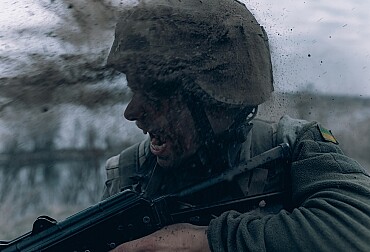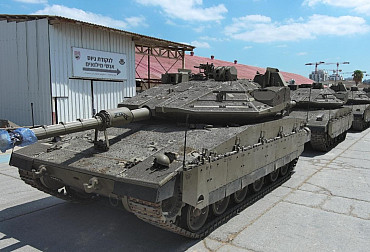Finland orders more of the XA-300 wheeled armoured personnel carriers by Patria
The Finnish Defence Forces are acquiring more Patria 6x6 vehicles through the additional purchase option included in the previously signed agreement. In the summer of 2023, Patria and the Defence Forces Logistics Command signed an agreement for 91 armoured personnel carriers with equipment. The procurement agreement included an additional purchase option for 70 vehicles, of which the Defence Forces previously redeemed 41 at the turn of 2023–2024, and now an additional 29 vehicles.

Finland has decided to purchase a further 29 XA-300 wheeled armoured personnel carriers under the option right included in the contract signed last June. The Finnish ground forces will thus receive a total of 161 vehicles of this type. The XA-300 vehicles, which is the local designation for the Patria 6x6 armoured personnel carrier, were ordered by Finland in June last year under a base order for 91 vehicles with an option for 70 more. In January, Finland exercised the option by buying 41 additional units. Now Patria Group has announced that it has received an order from the Department of Logistics of the Finnish Defence Forces to produce and deliver a further 29 XA-300s, thus completing the contract. The newly purchased vehicles are to be delivered by the end of 2025.
"Buying out the entire national additional purchase option is extremely important for Patria and the entire international joint CAVS programme. The programme is progressing rapidly due to excellent cooperation between Patria and the participating countries. The joint programme between nations enables cost-effective vehicle development and life-cycle support, rapid procurement, and equipment compatibility, strengthening defence cooperation in Europe," said Patria Group’s executive vice-president Jussi Järvinen.
Derived from the Patria AMV 8×8 carriers, replacing the Sisu Pasi
The value of the executive contract is set at €36.5 million, and, like previous contracts, includes a logistics and support package. The total framework contract is expected to close at €208 million. The new vehicles will ultimately replace the Patria Pasi XA-180/185 family of armoured personnel carriers previously used by the Finnish Army, an unspecified number of which have been transferred to Ukraine. Ultimately, the XA-300 will replace all the 6x6 KTOs currently used by the Finnish army, so a target order of more than 550 vehicles can be expected. It is worth mentioning that in April this year, Patria Group announced that it had received a contract from Finland for the delivery of a prototype KTO XA-300 (Patria 6x6) with reinforced armour, with an option for 19 further vehicles.
The Patria 6x6 is a three-axle Finnish armoured personnel carrier designed by Patria as a successor to the Sisu Pasi XA-180/185/200 series. The vehicle was developed based on the KTO XA-200, using components derived from the Patria AMV 8×8 carriers, which allows for greater unification between vehicles, lower operating costs, and reduced production costs for the new carrier. It is crewed by two soldiers, while the vehicle can transport up to eight personnel. The vehicle's armour is designed to provide protection levels 2 to 4 according to STANAG 4569. The power unit is a Scania DC09 074A diesel engine with 294 kW/400 hp, allowing the 24-tonne vehicle to reach a top speed of more than 100 km/h.
The XA-180/185/200 is also a 6×6 wheeled armoured personnel carrier, developed in the 1980s by Sisu. The first XA-180 entered service in 1984, known also as Pasi (Panssari-Sisu, or "Armoured Sisu" in Finnish). It was developed at the request of the Finnish Army to replace the old Soviet BTR-60 armoured personnel carriers. The XA-180 itself was based on the Sisu SA-150 heavy truck. The vehicle was developed in several versions and exported to the Netherlands, Norway, Sweden, Ireland, and Estonia. Various versions of the XA-180 have been deployed in Afghanistan, Bosnia, Iraq, Kosovo, Lebanon, Somalia, Chad, and Ukraine.
Its successor, the Patria 6x6, can be fitted with a remotely controlled armament module or a manned turret system equipped with, for example, large-calibre machine guns, automatic grenade launchers, or automatic cannons of various calibres. The Patria 6x6 can also serve as the base for a number of specialised versions, such as a company command vehicle, self-propelled mortar (120 mm Patria NEMO), medical evacuation vehicle, heavy APC, radio-electronic warfare vehicle, or self-propelled air defense vehicle. The vehicles are currently in service with the armed forces of Finland, Latvia, and Sweden, and may also be used by Germany in the future.
Patria 6x6 for the Bundeswehr
“We are pleased to start a unique partnership that will provide enormous added value for Germany. We offer to adapt for German needs a cost-effective, fully developed, off-the-shelf platform – the Patria 6x6 – that is already in production, fielded by NATO partner nations, and will be produced locally in Germany to meet the high requirements and technical standards of the Bundeswehr,” commented Hugo Vanbockryck, Senior Vice President, Market Area Europe of Patria, in February.
The international Common Armoured Vehicles System (CAVS) programme, a multinational project to standardise armoured vehicle procedures and technologies between member states – including Finland, Latvia, Sweden, and Germany – chose the Patria 6x6 as the vehicle platform in 2019. It was selected as a modular, robust, and affordable vehicle platform for protected troop transport, offering high performance, modern protection, and exceptional mobility.
According to Bild, the Bundeswehr is expected to be equipped with the Patria 6x6 starting in 2026. A total of between 800 and 1,000 vehicles will be procured and will gradually replace the Fuchs armoured transport vehicle. A contract is expected to be signed in the second half of this year. The German Ministry of Defence has decided against the Fuchs Evolution armoured personnel carrier, developed by Rheinmetall. The decision to favour the Finnish solution over Rheinmetall’s vehicle was influenced by factors such as cost-effectiveness and the current state of production of the proposed models.








